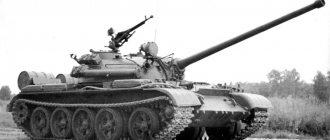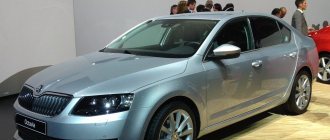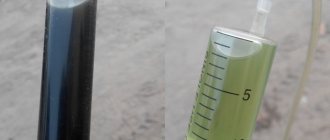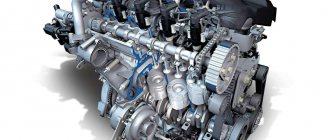The first versions of the preselective manual transmission appeared in the middle of the last century, and Adolf Kegress acted as the inspiration for the development. At that time, the transmission, which had hydromechanical control and a pair of clutches, seemed too complicated. They forgot about it and remembered only thirty years later in the Porsche company. Today, the Direkt Schalt Getrieb gearbox (translated as “direct gearbox”) is installed on many cars, including the new Skoda Kodiak crossover.
The history of the DSG transmission began with the light hand of the imperial driver.
Operating principle and types
The DSG gearbox operates on the principle of two parallel clutches:
- The first one works at an odd speed.
- The second is preparing the next gear (even) for inclusion. At a certain point, the second clutch takes over the load of the gearbox.
Thanks to the design feature, gears change almost instantly (it takes no more than a tenth of a second). For comparison, with classic automatic transmissions this time is an order of magnitude longer.
There are several types of DSG gearboxes:
- DSG-6, DQ250 - “box” with a “wet” type double clutch and six speeds. The production started in 2003. The gearbox is installed on cars with 1.6-3.2 liter engines from Skoda, Seat and Volkswagen.
- DSG-7, DQ200 - the next version of the seven-speed gearbox. Unlike the previous version, the new gearbox was designed for a torque of up to 250 N*m. Installed on Volkswagen Polo and Golf cars, as well as Seat Ibiza. Year of release: 2008.
- VAG - DQ500 - an improved gearbox with a wet clutch (500 Nm), installed on Volkswagen Tiguan (Chinese assembly), Transporter, new Skoda Kodiak and other cars.
Dimensions (dimensions)
Length – 4697 mm Width – 1882 mm Height – 1676 mm Wheelbase – 2791 mm Ground clearance – 194 mm Front track 1586 Rear track – 1576 mm Luggage compartment volume in a 5-seater version – 720/2065 l Luggage compartment volume in a 7-seat version local modification - 270/630/2005 l Volume of compartments for hand luggage in the cabin - about 30 l Wheel size - 215 / 65 / R17 Fuel tank volume - 58 l
Front suspension type - independent, spring Rear suspension type - independent, spring Front brakes - ventilated disc Rear brakes - disc
Number of seats in the cabin - 3 rows of seats for 5 or 7 people (including the driver) depending on the configuration
Skoda Kodiak interior space size
| Front elbow space min/max (mm): | 830/1060 |
| Space at elbow level in second row min/max (mm): | 400/890 |
| Elbow room in third row min/max (mm): | 510/680 |
| Front seat height (mm): | 960 |
| Height above the seat in the second row (mm): | 940 |
| Height above the seat in the third row (mm): | 870 |
| Front Width (mm): | 1540 |
| Width in second row (mm): | 1510 |
| Width in third row (mm): | 1290 |
| Front Seat Length (mm): | 480 |
| Second row seat length (mm): | 450 |
| Third row seat length (mm): | 360 |
| Seat back height, front (mm): | 650 |
| Seat back height in second row (mm): | 640 |
| Backrest height in third row (mm): | 530 |
Luggage compartment volume Skoda Kodiak
| Luggage compartment volume in 5-seater version [l] | 720 /2065* |
| Luggage compartment volume in 7-seater version [l] | 270 /630* /2005* |
| Luggage compartment length in 5-seater version [mm] | 1090 — 1270 |
| Luggage compartment length in 7-seater version [mm] | 470 |
| Luggage compartment width [mm] | 1000 |
| Height of luggage compartment under floor [mm] | 440-680 |
* With rear seatbacks folded down.
Common problems with DSG-6 and DSG-7
The advantages of the DSG series transmissions are obvious:
- Reducing the time required to accelerate a car.
- Fuel saving.
- Smooth gear shifting (without obvious jerks).
- No clutch pedal.
- Possibility of switching to manual control.
This is what the DSG-6 looks like.
Despite this, the DSG-7 and DSG-6 gearboxes have common problems that car owners, including owners of the Skoda Kodiak 2021, may encounter:
- The chips that accumulate during drum operation carry double risks. On the one hand, it negatively affects the filter and gearbox elements, and on the other, it harms the electrical components (sensors, solenoids, etc.). When chip hedgehogs increase to 2-3 mm, it is recommended to overhaul and clean the DSG Skoda Kodiaq. If repairs are not carried out in a timely manner, the chips damage the gaskets and seals of the transmission, which will require the purchase of a repair kit and a gearbox overhaul.
- A common problem with the DSG-7 and DSG-6 transmissions is mechatronics, which is explained by the special setting of the computer to overload the drums. Due to excessive wear, the valves and electrical parts of the car suffer. To avoid problems, it is important to eliminate the influence of static electricity on mechatronics during repairs.
- Prolonged operation of the transmission with chips in the lubricant leads to breakdown of the solenoids. The ones that suffer the most are the VFS - the elements that provide pressure regulation in the C1 C2 packages. It is recommended to replace these parts along with the cooling solenoids.
And this is DSG-7.
The numerous advantages of this type of transmission encourage many to buy a Skoda Kodiak with DSG. However, it is worth considering that the technical complexity of these nodes also implies a high probability of problems arising. Of course, Skoda Kodiaq owners will probably not encounter as many troubles as they did at the very beginning of the production of these transmissions by VAG. However, it is necessary to be prepared (including psychologically) for their occurrence. Unfortunately, it cannot yet be said that preselective boxes have gotten rid of all the shortcomings. Therefore, it is necessary to consider in detail both the causes of Skoda Kodiak DSG malfunctions and options for eliminating them.
Main malfunctions of DSG-6, DQ250
Despite a number of advantages, the DQ250 has a poorly thought-out design, due to which the 2-pack clutch often fails.
Car owners also have to deal with problems with mechatronics and the clutch drum. A popular repair technique is the installation of new solenoids to replace the complex “original” ones, which have wear-out hydraulic plates in their design (made using an anodized alloy). It is recommended to change consumables, rings and clutches along with them.
DSG transmission solenoids Skoda Kodiak.
After entering the measurements into the ECU program, the transmission resource increased and almost reached the levels that competitors could boast of.
The main problems with the DQ250 that owners of the Skoda Kodiak and other cars with such a transmission may encounter are the appearance of vibrations, trembling and jerking caused by the operating features of the 2-disc clutch. In combination with metal shavings in the gearbox, this “kills” the electronic-hydraulic unit of the car (mechatronics).
To avoid problems when operating the Skoda Kodiak, it is worth considering:
- The oil and external heat exchanger filter should be changed after 50,000 - 60,000 km. Original for DSG-6, DQ250 - G 052182 A2.
- Simultaneously with changing the oil, it is worth dismantling and removing the pan to clean out accumulated chips. If there is a lot of it, it is better to disassemble the transmission and make preventive repairs.
- Due to the negative effects of dirty oil, VFS solenoids are quickly “eaten up”, which impairs the performance characteristics of the part. Solenoids are not able to properly change and regulate oil pressure. As a result, a conflict between the computer and these nodes arises (mechatronics refuses to work).
The solenoids responsible for switching clutches (located in the milked drum) break down the fastest. The main pressure solenoids also carry a greater load, which, when operating in overheated and contaminated oil, are more susceptible to wear. As a result, shocks and shocks occur during transmission operation.
An example of a repair kit for a DSG.
The worst thing is when the solenoids responsible for switching quality fail. If the part is worn out, the computer turns on emergency mode and leaves the driver with only one speed (to get to the service station).
- To extend the life of solenoids and clutches, timely replacement of filters, seals and rings is recommended. If you change the solenoid, but leave the rings, the problem does not disappear. Due to ring wear, the solenoids will operate at maximum load, which will reduce their service life.
Thus, specific malfunctions of the DSG-6, DQ250 Skoda Kodiaq include:
- Wear of the friction clutch, due to which the DSG ISkoda Kodiak goes into emergency mode or jerks appear during operation. The solution is to replace the faulty part up to 150,000 kilometers.
- Wear of solenoids that regulate pressure in mechatronics. It appears jerky when changing gears. The solution is to install new solenoids or completely replace the entire assembly.
- Failures in the electronic transmission unit (more precisely, the mechanics). They manifest themselves by periodically switching to emergency mode during a cold start. The solution is replacement or repair.
- Wear of the dual-mass flywheel. Symptoms: extraneous noise at idle, when stopping and starting the engine. To fix the problem, the flywheel is changed.
- Worn bearing mounted on the input shaft or failure of the transmission differential. Symptoms are increased gearbox noise, which increases with increasing speed and when cornering. The solution is a major overhaul or replacement of the transmission.
Main faults of DSG-7, DQ500
A newer development, which appeared only in 2009, is the DSG-7 transmission, DQ500 with a wet clutch and seven gears. It is created for engines capable of developing torque up to 500 N*m, and the main feature is the minimal need for adding oil. While the DSG6 requires 6.4 liters, the new transmission only needs 2 liters. Today, the DQ500 gearbox is installed on many cars (Volkswagen, Audi, Seat, Skoda), including the Skoda Kodiak.
Clutch of preselective transmission Skoda Kodiak.
The DSG-7, DQ500 series is intended for expensive cars. Its advantages are reliability, long service life of components and minimal operating requirements. But there are also disadvantages:
- Heavy weight.
- High price.
- Fear of overheating (heat exchanger suffers). The latter may become clogged after 3-5 years and require replacement.
When operating a Skoda Kodiak with DQ500, it is worth considering:
- The oil is changed after 60,000 km (with quiet driving). If the driver prefers an aggressive driving style, the oil is changed earlier.
- Together with the lubricating fluid, a new external filter cartridge is installed, by the appearance of which you can judge the service life of the gearbox and the need for major repairs.
- The internal oil filter should only be changed when the transmission is overhauled.
- The seal and gasket repair kit may not include a gasket for the pan, as well as axle seals. They often need to be ordered separately.
- There may be problems with the mechatronics, which are sensitive to dirt from the clutch basket.
Manual transmission Skoda Kodiak
Traditionally, the review begins with the manual transmission. It is standard in 6 steps. Drivers receive a familiar mechanism that is reliable and durable. Maintenance is much cheaper than a machine, which suits the average citizen of our country with a small income.
In addition to Skoda cars, mechanics can be found in other branches of the manufacturer. There are also a number of cars belonging to the VAG group that use a similar manual transmission. The following giants should be included here: Audi, SEAT, Volkswagen. By replacing a crossover from one manufacturer to another, you can end up with familiar driving characteristics with all the pros and cons.
You can find mechanics on the Skoda Kodiak by purchasing the following engine models:
- 1.4 l per 125 l. With. – front-wheel drive;
- 1.4 l per 125 l. With. – all-wheel drive;
- 2.0 l per 150 l. With. – all-wheel drive.
There is plenty to choose from. If for a 2.0 liter engine a manual gearbox may seem like an overkill, then it is definitely indispensable on the 1.4 liter version: you can squeeze out much more. Standard 123 l. With. Now they already look very doubtful.
There is enough power for city driving, but not enough on the highway or over rough terrain. The only thing that saves is the driver’s ability to properly control the gearbox, where potential is always hidden, which in skillful hands can easily be released.











